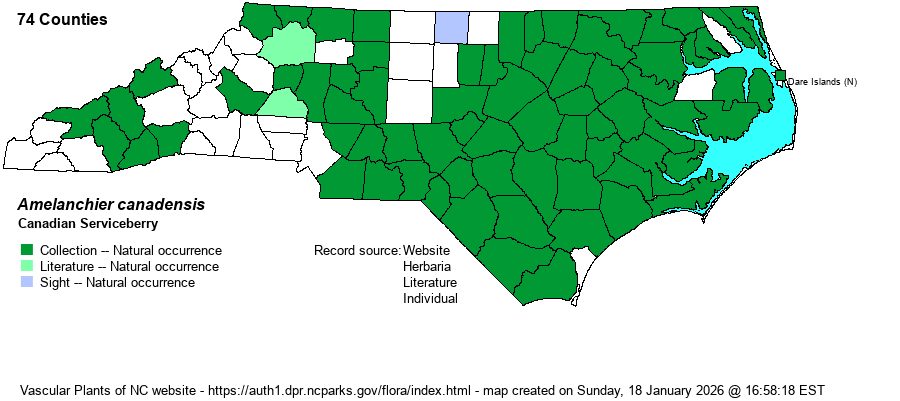| Author | (L.) Medikus | |
| Distribution | Primarily the eastern half of the state. Found in nearly all Coastal Plain counties, as well as nearly all Piedmont counties close to the Fall Line. Widely scattered across the central and western Piedmont, with scattered records for the Mountains, generally those with lower elevations. Possibly absent in some western Piedmont and some Mountain counties.
This species ranges from eastern Canada south to GA and MS, mainly found in states bordering the Atlantic; there are no records for OH and KY westward. | |
| Abundance | Infrequent to fairly common in the Coastal Plain, but rare to uncommon in the lower Piedmont. Generally rare in the remainder of the Piedmont and lower Mountains. Typically much less commonly seen than Coastal Serviceberry (A. obovalis) in the Coastal Plain, and certainly less often seen than Downy Serviceberry (A. arborea) in the rest of the state. | |
| Habitat | This species occurs mainly in wetlands, but not in flooded areas such as swamps. It favors damp, sandy soils of pocosin margins, wet flatwoods, wet streamheads, margins of bottomlands, and damp thickets or pool margins. It can occur in somewhat drier soils, such as maritime forests and thickets. |
| Phenology | Flowers in early spring (March and April), usually before leaves are developed. Fruits generally in May and June. | |
| Identification | This deciduous species is primarily a tall shrub, occasionally reaching small tree stature; most individuals grow to about 10 feet tall. It is not a rhizomatous species like some others in the genus; individuals grow singly. Even so, each plant usually contains many stems emerging from the ground, and thus has a shrub-like form unlike most others in the genus. It has elliptical leaves that are rounded at the base, as opposed to cordate; Downy Serviceberry has cordate leaf bases. Canadian Serviceberry leaves are not wider toards the tip, unlike leaves of Downy Serviceberry. It can be separated from the two other Coastal Plain species – A. obovalis and A. spicata – by growing singly instead of clonally (in dense colonies), and usually by the multi-stemmed trunk (along with taller height). The latter two species generally have shorter petals, as well. | |
| Taxonomic Comments | Some references and authors ascribe varieties to this species, whereas many others do not. Neither Weakley (2018) nor NatureServe list varieties for it.
| |
| Other Common Name(s) | Eastern Serviceberry, Juneberry, Shadblow Serviceberry | |
| State Rank | S4 | |
| Global Rank | G5 | |
| State Status | | |
| US Status | | |
| USACE-agcp | FAC link |
| USACE-emp | FAC link |

